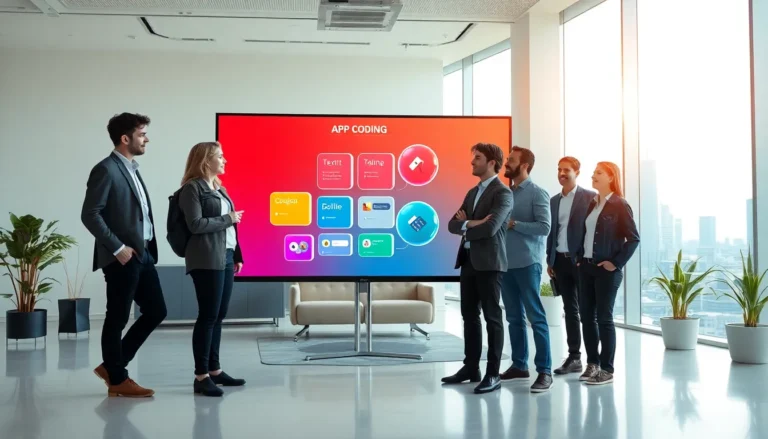In a world where coding can feel like trying to decipher ancient hieroglyphics, no-code software swoops in like a superhero with a cape made of user-friendly interfaces. Imagine building apps, websites, and automations without needing a degree in computer science. Sounds like magic, right? Well, it’s just the power of no-code tools, making tech accessible to everyone from entrepreneurs to busy professionals.
Table of Contents
ToggleOverview of No-Code Software
No-code software simplifies the development of applications and websites, catering to users lacking technical expertise. These platforms rely on visual interfaces and drag-and-drop functionality, making it intuitive for anyone to build digital products. Entrepreneurs and busy professionals leverage no-code tools to create unique solutions rapidly, saving both time and resources.
Businesses see significant benefits from adopting no-code software, such as reducing dependency on IT teams. By allowing individuals to manage projects independently, no-code platforms streamline workflows. Various industries, including healthcare, finance, and education, adopt these tools to enhance productivity and innovation.
Some popular no-code platforms include Bubble, Webflow, and Airtable, each offering distinct features to meet diverse needs. Bubble excels in web application development, while Webflow specializes in responsive design and site building. Airtable combines spreadsheet functionality with database features, enabling effective project management.
Users appreciate no-code software for its ability to integrate with existing applications and services. Many platforms support integrations with APIs, allowing seamless data exchange and enhancing overall functionality. This connectivity increases the versatility of no-code solutions, further appealing to startups and small businesses.
Adopting no-code software provides significant advantages such as rapid prototyping and testing. Teams can iterate quickly based on user feedback, facilitating an agile development process. As a result, organizations can respond promptly to market changes and customer demands, ensuring their solutions remain relevant.
Key Features of Top No-Code Software
Top no-code software platforms offer several key features that enhance accessibility and functionality for users.
User-Friendly Interface
No-code platforms prioritize user-friendly interfaces, making it easy for anyone to navigate. Visual elements guide users through the process of app and website creation. Drag-and-drop functionality allows for intuitive design, reducing the steep learning curve typically associated with coding. Clear workflows further streamline project development, ensuring that even novices can successfully build digital products. Examples of successful projects highlight the effectiveness of these interfaces, demonstrating their ability to empower users from various backgrounds.
Integration Capabilities
Integration capabilities define the versatility of no-code software. Platforms often connect seamlessly with existing applications and services, facilitating smooth data exchange. Many integrations enable users to combine functionalities from different tools, creating comprehensive solutions. For instance, Airtable connects with tools like Slack and Google Drive, enhancing collaboration and project management. These capabilities allow teams to tailor their workflows, ensuring that no-code solutions fit into diverse operational environments and workflows.
Customization Options
Customization options cater to specific user needs while maintaining ease of use. Users can modify templates and design elements to create unique solutions that reflect their brand identity. Flexibility in workflows allows for adjustment based on project requirements rather than adhering to a one-size-fits-all approach. Features such as custom fields, conditional logic, and variable integrations provide greater control over functionality. This level of personalization contributes to user satisfaction and results in effective digital solutions that meet varying demands in diverse industries.
Benefits of Using No-Code Software
No-code software offers numerous advantages that cater to various user needs. From cost efficiency to rapid development, these platforms transform how individuals and businesses approach technology.
Cost Efficiency
No-code software significantly lowers development costs. Businesses save by minimizing reliance on expensive software development teams. The reduction in the need for specialized skills enables organizations to allocate budgets more efficiently. Many platforms operate on subscription models, making it affordable for startups and small businesses. Moreover, teams can deploy solutions without incurring overhead associated with traditional coding.
Speed of Development
Speed of development is a major benefit of no-code software. Teams build and launch applications in days or weeks instead of months. Rapid prototyping allows for quick iterations based on user feedback. Efficiency increases as non-technical users can take charge of their projects. Adapting to market changes becomes easier when solutions can be modified in real-time. Consequently, companies respond to customer demands faster, gaining competitive advantages.
Popular No-Code Software Options
Numerous no-code software options simplify development and encourage innovation. Each platform caters to various needs, making it easy for users to choose the right fit.
Bubble
Bubble stands out in web application development. It offers a powerful visual editor, allowing users to create complex applications without coding. Drag-and-drop functionality facilitates customizing designs and workflows. Users can also set up dynamic data structures, enhancing user experience. Bubble’s flexibility appeals to entrepreneurs looking to launch MVPs quickly. Various integrations with APIs expand its capabilities, ensuring users can connect with other applications easily.
Webflow
Webflow excels in responsive web design. Designers appreciate its ability to create visually stunning websites while incorporating a robust Content Management System (CMS). Unique features like animations and interactions allow users to craft engaging experiences without writing code. Webflow provides templates that streamline development for users of all skill levels. Additionally, users can export clean HTML and CSS, offering flexibility for further refinement if necessary.
Airtable
Airtable combines spreadsheet functionality with database features effectively. Users enjoy its intuitive interface, which allows seamless collaboration across teams. Tailored templates accommodate various use cases, from project management to event planning. Integrating Airtable with other tools enhances productivity and ensures projects stay organized. Automation features streamline workflows, enabling users to focus on higher-priority tasks. This versatility makes Airtable an ideal choice for businesses of all sizes seeking a user-friendly solution.
No-code software is transforming the way individuals and businesses approach technology. By removing barriers to entry for app and website development, these tools empower users to innovate without needing extensive coding knowledge.
As industries continue to evolve, the demand for efficient and accessible solutions will only grow. No-code platforms are well-positioned to meet this need, offering flexibility and speed that traditional development methods often lack.
Embracing no-code software not only enhances productivity but also fosters creativity, allowing users to focus on what truly matters—bringing their ideas to life. With the right no-code tools, anyone can become a creator in the digital landscape.










